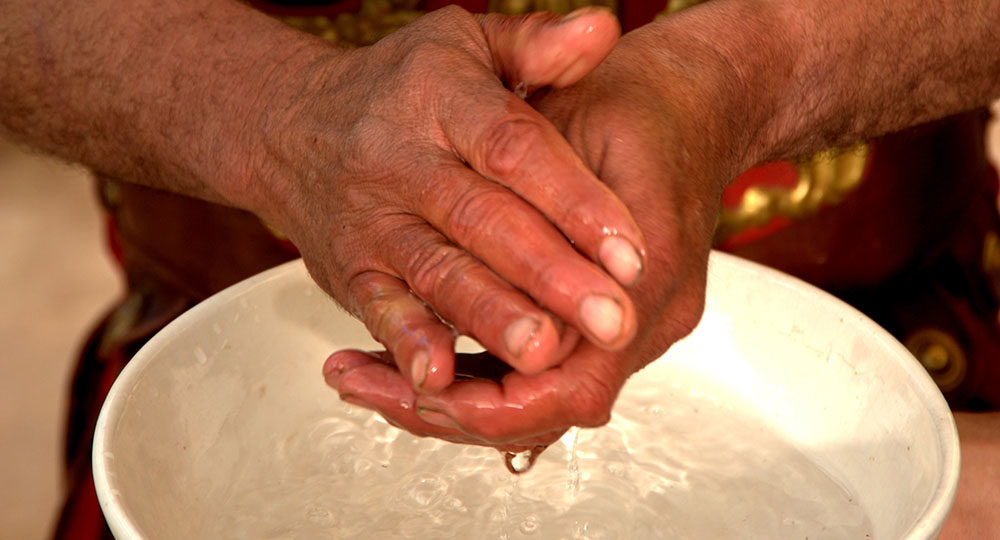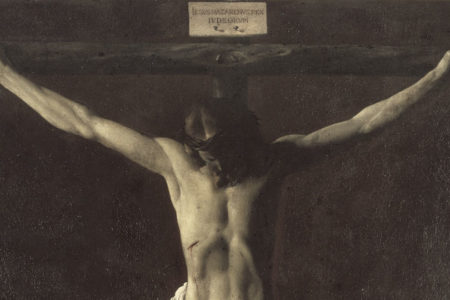Behold the Man!
“What is truth?” The words rang out like the vibration of an endless sound wave echoing through the universe. Can one know the truth? Is truth the elusive goal of man’s fertile imagination? Is it something to be grasped and embraced, or is it as fickle as the wind? Pontius Pilate’s question, recorded in John 18:38, has haunted mankind almost from the beginning of time.
Procurator of Judea
Herod Archelaus, who ruled over the area of Judea as part of his kingdom, died in 6 A.D. Roman oversight of Judea was then turned over to a procurator, or governor. A procurator personally served the emperor. He was primarily in charge of the financial concerns of his area, but the extent of his powers varied depending on the whims of his emperor.
Pontius Pilate, who ruled from 26 to 36 A.D., was the fifth procurator over the area of Judea. Accounts of his character record that “he is cruel by nature and so stubborn that nothing changes his mind.” In his time as procurator, it was said that “bribery, robbery, exploitation, insults, frequent executions without trial, and cruelty without end or limit” were the norm.
Pilate’s rule over Judea included much more than just oversight of the area’s finances. He was a procurator cum potestate. He had authority not only in the area of Roman finances for Judea, but he possessed military, civil, and criminal authority. Under all procurators, including Pilate, the Jewish people had limited authority up to the death penalty. The sentence of death resided only with the Roman authority.
Pilate and the Jews
The four procurators prior to Pilate had no problems with the Jewish community. Josephus, the foremost Jewish historian of the time, records that there were no instances of conflict during the reign of these men. Undoubtedly there were some tensions between the two communities, but the Romans understood the sensitivity of the Jewish people to things that would defile them and their religion. Care was thus taken not to offend the Jewish citizens of this Roman province. Pilate was different.
For centuries, the Jewish people had despised any type of graven image. Jehovah forbade them from making or owning any such images. But the Roman army carried standards bearing images of the emperor. Understanding the religious concerns of the Jewish citizens, the procurators instructed their soldiers not to use the standards so as not to provoke an uprising.
When Pilate became procurator, he held the Jews and their laws in contempt. Wanting to show his authority and express his contempt for these people and their beliefs, he ordered his soldiers to enter Jerusalem under darkness with their standards bearing the image of the emperor. Why, he reasoned, should this city be different from any of the other Roman cities, all of which had images of the emperor?
When dawn broke and the Jewish people saw the image-bearing standards in their holy city, they were infuriated. Seven thousand people marched to Cæsarea, where Pilate resided. For five days, Pilate’s home was surrounded. He was asked to remove the image-bearing standards. Continuous prayers were made for the removal of the idolatrous images.
On the sixth day, Pilate relented. He told the protesters that he would set up a judgment seat in an open area of the city and hear their request. Pilate was not as stubborn as this religiously motivated crowd, but his maliciousness matched their stubbornness. The Jewish protesters assembled in the open area of the marketplace. Pilate ordered his soldiers to surround them. He told the seven thousand that if they did not desist from their demands, he would immediately have them killed. The response of these Jewish people surprised even this hardened, cruel ruler.
As Josephus records it, “They stretched out their throats to the swords and cried that they were ready to die rather than transgress the laws of their faith.” Their moral conviction and willingness to give their lives for their beliefs impressed even Pilate. He ordered that the image-bearing standards be removed from Jerusalem and the people went home.
But Pilate’s antagonism toward the Jewish people and their religion surfaced again. Shortly after the incident in Cæsarea, Pilate confiscated some of the Temple treasury to build an aqueduct to supply water to Jerusalem. This action infuriated many people in Jerusalem. Not wanting to be put in the same predicament as before, Pilate ordered some of his soldiers to dress as civilians and mingle with the crowd carrying hidden weapons. When a protest rebellion began to form, the soldiers attacked the crowd and many Jews were killed. The rebellion was short-lived.
Pilate and Jesus
The festival of Passover had arrived. Hundreds of thousands of Jewish people had come to Jerusalem for this first pilgrimage festival of the year. Roman soldiers were stationed throughout the city. Pilate knew that the Jewish people despised his rule. The multitude of people in the city produced circumstances ripe for a revolt.
In the midst of all the commotion, Jesus had partaken of the Passover with His disciples. They had celebrated their freedom from Egyptian slavery, sacrificed and eaten the Passover lamb, and worshiped together at the Passover Seder. At this feast, Jesus proclaimed that He was the ultimate Lamb of God and the deliverer from the slavery of sin.
The Charge
The leaders of the Jewish people, led by Caiaphas the high priest, were incensed over Jesus. Multitudes had flocked to His teachings. A satanic jealousy ruled the hour. Judas had conspired with the chief priests to turn Jesus over to them for money, which he did by betraying Him with a kiss.
Jesus was taken to the home of Caiaphas. There He was tried on several false charges by Caiaphas and a few of the leaders of the priests and scribes. The verdict was guilty. Jesus was sent to Pilate for sentencing. The mile or so walk from Caiaphas’ home to Pilate’s dwelling must have seemed like an eternity to those involved in this blasphemy of justice. Finally, Jesus arrived at the Fortress of Antonia (the Jerusalem dwelling place of Pilate, according to Jewish law), located to the north of the Temple overlooking the Temple area.
One by one, the accusations were made against Jesus. The religious leaders anticipated that the death penalty would be meted out as a result of their charges. “We found this fellow perverting the nation, and forbidding to give tribute to Cæsar, saying that he himself is Christ, a king” (Lk. 23:2). Pilate was not impressed by their accusations. Enraged, their response came quickly: “He stirreth up the people, teaching throughout all Judæa, beginning from Galilee to this place” (Lk. 23:5). He is leading a revolt against the Roman authority; His acts are treasonous, claimed these few religious leaders.
Even when Pilate wanted to release Jesus, the religious leaders cried out, “If thou let this man go, thou art not Cæsar’s friend; whosoever maketh himself a king speaketh against Cæsar” (Jn. 19:12).
The Conflict
Pilate was caught between the proverbial rock and a hard place. He recognized Jesus’ innocence, but if he released Him he might have another riot on his hands. He well remembered the zealousness of these religious people at his home in Cæsarea. But if he sentenced this innocent man to death, he feared the response of the common people. As much as some of the religious leaders despised and hated this Jesus, the common people of the Jewish community had embraced Him wholeheartedly.
Pilate saw a possible way out of his predicament. Pilate had heard that Jesus had been teaching in Galilee, so he asked if Jesus was from that area. Upon learning that He was, he sent Jesus to Herod Antipas, who was also in Jerusalem at the time. Being a Galilean, Pilate knew that Jesus belonged under Herod Antipas’ jurisdiction. But the ploy did not work. Although Herod wanted to see this “miracle” worker, he did not remove the responsibility from Pilate. The religious leaders made the same accusations about Jesus before Herod. When Jesus did not defend Himself, Herod and his men mocked Him and sent Him back to Pilate.
Pilate was now faced with a perplexing problem. He saw no wrong in Jesus’ actions nor any substance in the religious leaders’ charges. Pilate responded to their cries with the clear statement, “I find no fault in this man” (Lk. 23:4). Later he added, “behold, I, having examined him before you, have found no fault in this man touching those things of which ye accuse him” (Lk. 23:14).
One other possibility came to Pilate’s mind. It was customary on Passover to release a criminal. Pilate offered the choice of Jesus or Barabbas, a thief and a murderer. The cry from the religious leaders and the multitude was haunting: Release to us Barabbas; sentence Jesus. When Pilate asked what should be done with Him, their cry was, “Crucify him! Crucify him!” (Lk. 23:21).
The stage had been set for the climactic event of all human history. The Son of God, who became the Son of Man, was now going to accomplish that for which He came. Jesus would die for the sins of the world—and rise from the grave in victory over death and sin.
Even though he was a hardened and despotic ruler, Pilate must have been vexed in his soul. Three times he had argued for Jesus’ release. The reply was the same each time: “Crucify him!” The mob of people was unruly, loud, and incessant. Pilate saw no alternative but to acquiesce to the demands of these few. Jesus was turned over to the Roman authorities to be crucified.
Behold the Man!
Pilate tried to separate himself from the injustice that was taking place. “He took water, and washed his hands before the multitude, saying, I am innocent of the blood of this righteous person” (Mt. 27:24).
But was he? He was in a place of authority and responsibility where he could have seen to it that justice prevailed. His capitulation to the desires of the crowd made him as guilty as the inciters.
All four of the Gospels cover this miscarriage of justice. The actions of Pilate and the others in the trial and sentencing of Jesus were inexcusable. In reality, though, the people involved in this sequence of events were as much on trial as was Jesus. Would they do what was right? Would they be swayed by the pressure of the crowd? Would truth and justice win the day? The participants in this drama were guilty of denying the truth and rejecting justice.
We, in essence, are in the same place as the participants in that trial. Truth can be known! Truth can be embraced! When Pilate cried out, “Behold the man!” (Jn. 19:5), he was unwittingly helping to fulfill a prophecy from Zechariah 6:12. Jesus was the one foretold by that Jewish prophet and identified by Pilate. He is the truth, attested to by the messianic prophecies of the Jewish Bible. That is why Jesus could proclaim, “I am the way, the truth, and the life; no man cometh unto the Father, but by me” (Jn. 14:6).
Will we let the majority sway us? Will we deny the truth? Will we do what is right? Will we embrace Him, the truth, who died unjustly for our sins and rose from the grave?
What is your verdict?







